Yuang Liu
Nested-TNT: Hierarchical Vision Transformers with Multi-Scale Feature Processing
Apr 20, 2024Abstract:Transformer has been applied in the field of computer vision due to its excellent performance in natural language processing, surpassing traditional convolutional neural networks and achieving new state-of-the-art. ViT divides an image into several local patches, known as "visual sentences". However, the information contained in the image is vast and complex, and focusing only on the features at the "visual sentence" level is not enough. The features between local patches should also be taken into consideration. In order to achieve further improvement, the TNT model is proposed, whose algorithm further divides the image into smaller patches, namely "visual words," achieving more accurate results. The core of Transformer is the Multi-Head Attention mechanism, and traditional attention mechanisms ignore interactions across different attention heads. In order to reduce redundancy and improve utilization, we introduce the nested algorithm and apply the Nested-TNT to image classification tasks. The experiment confirms that the proposed model has achieved better classification performance over ViT and TNT, exceeding 2.25%, 1.1% on dataset CIFAR10 and 2.78%, 0.25% on dataset FLOWERS102 respectively.
DMT: Comprehensive Distillation with Multiple Self-supervised Teachers
Dec 19, 2023Abstract:Numerous self-supervised learning paradigms, such as contrastive learning and masked image modeling, have been proposed to acquire powerful and general representations from unlabeled data. However, these models are commonly pretrained within their specific framework alone, failing to consider the complementary nature of visual representations. To tackle this issue, we introduce Comprehensive Distillation with Multiple Self-supervised Teachers (DMT) for pretrained model compression, which leverages the strengths of multiple off-the-shelf self-supervised models. Our experimental results on prominent benchmark datasets exhibit that the proposed method significantly surpasses state-of-the-art competitors while retaining favorable efficiency metrics. On classification tasks, our DMT framework utilizing three different self-supervised ViT-Base teachers enhances the performance of both small/tiny models and the base model itself. For dense tasks, DMT elevates the AP/mIoU of standard SSL models on MS-COCO and ADE20K datasets by 4.0%.
Language-guided Few-shot Semantic Segmentation
Nov 23, 2023Abstract:Few-shot learning is a promising way for reducing the label cost in new categories adaptation with the guidance of a small, well labeled support set. But for few-shot semantic segmentation, the pixel-level annotations of support images are still expensive. In this paper, we propose an innovative solution to tackle the challenge of few-shot semantic segmentation using only language information, i.e.image-level text labels. Our approach involves a vision-language-driven mask distillation scheme, which contains a vision-language pretraining (VLP) model and a mask refiner, to generate high quality pseudo-semantic masks from text prompts. We additionally introduce a distributed prototype supervision method and complementary correlation matching module to guide the model in digging precise semantic relations among support and query images. The experiments on two benchmark datasets demonstrate that our method establishes a new baseline for language-guided few-shot semantic segmentation and achieves competitive results to recent vision-guided methods.
ES-MVSNet: Efficient Framework for End-to-end Self-supervised Multi-View Stereo
Aug 04, 2023Abstract:Compared to the multi-stage self-supervised multi-view stereo (MVS) method, the end-to-end (E2E) approach has received more attention due to its concise and efficient training pipeline. Recent E2E self-supervised MVS approaches have integrated third-party models (such as optical flow models, semantic segmentation models, NeRF models, etc.) to provide additional consistency constraints, which grows GPU memory consumption and complicates the model's structure and training pipeline. In this work, we propose an efficient framework for end-to-end self-supervised MVS, dubbed ES-MVSNet. To alleviate the high memory consumption of current E2E self-supervised MVS frameworks, we present a memory-efficient architecture that reduces memory usage by 43% without compromising model performance. Furthermore, with the novel design of asymmetric view selection policy and region-aware depth consistency, we achieve state-of-the-art performance among E2E self-supervised MVS methods, without relying on third-party models for additional consistency signals. Extensive experiments on DTU and Tanks&Temples benchmarks demonstrate that the proposed ES-MVSNet approach achieves state-of-the-art performance among E2E self-supervised MVS methods and competitive performance to many supervised and multi-stage self-supervised methods.
Dynamic Token-Pass Transformers for Semantic Segmentation
Aug 03, 2023Abstract:Vision transformers (ViT) usually extract features via forwarding all the tokens in the self-attention layers from top to toe. In this paper, we introduce dynamic token-pass vision transformers (DoViT) for semantic segmentation, which can adaptively reduce the inference cost for images with different complexity. DoViT gradually stops partial easy tokens from self-attention calculation and keeps the hard tokens forwarding until meeting the stopping criteria. We employ lightweight auxiliary heads to make the token-pass decision and divide the tokens into keeping/stopping parts. With a token separate calculation, the self-attention layers are speeded up with sparse tokens and still work friendly with hardware. A token reconstruction module is built to collect and reset the grouped tokens to their original position in the sequence, which is necessary to predict correct semantic masks. We conduct extensive experiments on two common semantic segmentation tasks, and demonstrate that our method greatly reduces about 40% $\sim$ 60% FLOPs and the drop of mIoU is within 0.8% for various segmentation transformers. The throughput and inference speed of ViT-L/B are increased to more than 2$\times$ on Cityscapes.
LMSeg: Language-guided Multi-dataset Segmentation
Feb 27, 2023



Abstract:It's a meaningful and attractive topic to build a general and inclusive segmentation model that can recognize more categories in various scenarios. A straightforward way is to combine the existing fragmented segmentation datasets and train a multi-dataset network. However, there are two major issues with multi-dataset segmentation: (1) the inconsistent taxonomy demands manual reconciliation to construct a unified taxonomy; (2) the inflexible one-hot common taxonomy causes time-consuming model retraining and defective supervision of unlabeled categories. In this paper, we investigate the multi-dataset segmentation and propose a scalable Language-guided Multi-dataset Segmentation framework, dubbed LMSeg, which supports both semantic and panoptic segmentation. Specifically, we introduce a pre-trained text encoder to map the category names to a text embedding space as a unified taxonomy, instead of using inflexible one-hot label. The model dynamically aligns the segment queries with the category embeddings. Instead of relabeling each dataset with the unified taxonomy, a category-guided decoding module is designed to dynamically guide predictions to each datasets taxonomy. Furthermore, we adopt a dataset-aware augmentation strategy that assigns each dataset a specific image augmentation pipeline, which can suit the properties of images from different datasets. Extensive experiments demonstrate that our method achieves significant improvements on four semantic and three panoptic segmentation datasets, and the ablation study evaluates the effectiveness of each component.
Nebula-I: A General Framework for Collaboratively Training Deep Learning Models on Low-Bandwidth Cloud Clusters
May 19, 2022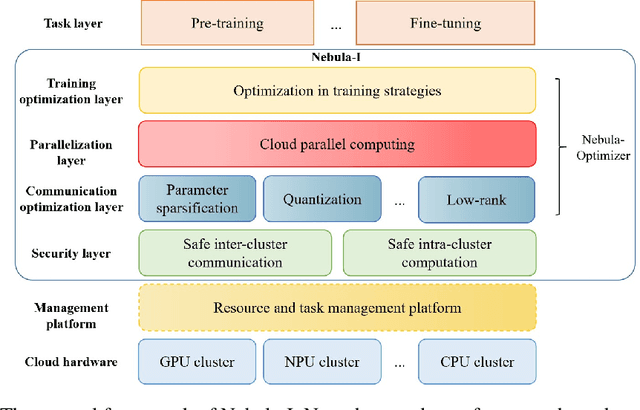

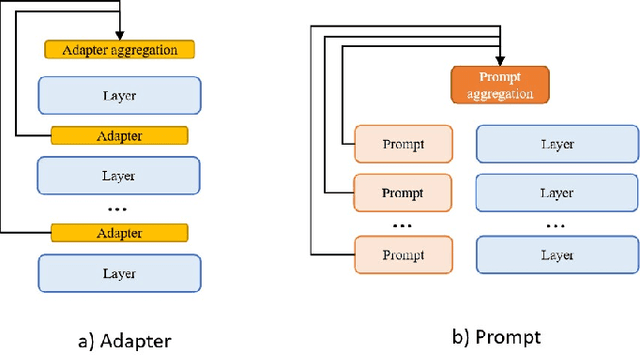

Abstract:The ever-growing model size and scale of compute have attracted increasing interests in training deep learning models over multiple nodes. However, when it comes to training on cloud clusters, especially across remote clusters, huge challenges are faced. In this work, we introduce a general framework, Nebula-I, for collaboratively training deep learning models over remote heterogeneous clusters, the connections between which are low-bandwidth wide area networks (WANs). We took natural language processing (NLP) as an example to show how Nebula-I works in different training phases that include: a) pre-training a multilingual language model using two remote clusters; and b) fine-tuning a machine translation model using knowledge distilled from pre-trained models, which run through the most popular paradigm of recent deep learning. To balance the accuracy and communication efficiency, in Nebula-I, parameter-efficient training strategies, hybrid parallel computing methods and adaptive communication acceleration techniques are jointly applied. Meanwhile, security strategies are employed to guarantee the safety, reliability and privacy in intra-cluster computation and inter-cluster communication. Nebula-I is implemented with the PaddlePaddle deep learning framework, which can support collaborative training over heterogeneous hardware, e.g. GPU and NPU. Experiments demonstrate that the proposed framework could substantially maximize the training efficiency while preserving satisfactory NLP performance. By using Nebula-I, users can run large-scale training tasks over cloud clusters with minimum developments, and the utility of existed large pre-trained models could be further promoted. We also introduced new state-of-the-art results on cross-lingual natural language inference tasks, which are generated based upon a novel learning framework and Nebula-I.
Data-Free Knowledge Transfer: A Survey
Dec 31, 2021



Abstract:In the last decade, many deep learning models have been well trained and made a great success in various fields of machine intelligence, especially for computer vision and natural language processing. To better leverage the potential of these well-trained models in intra-domain or cross-domain transfer learning situations, knowledge distillation (KD) and domain adaptation (DA) are proposed and become research highlights. They both aim to transfer useful information from a well-trained model with original training data. However, the original data is not always available in many cases due to privacy, copyright or confidentiality. Recently, the data-free knowledge transfer paradigm has attracted appealing attention as it deals with distilling valuable knowledge from well-trained models without requiring to access to the training data. In particular, it mainly consists of the data-free knowledge distillation (DFKD) and source data-free domain adaptation (SFDA). On the one hand, DFKD aims to transfer the intra-domain knowledge of original data from a cumbersome teacher network to a compact student network for model compression and efficient inference. On the other hand, the goal of SFDA is to reuse the cross-domain knowledge stored in a well-trained source model and adapt it to a target domain. In this paper, we provide a comprehensive survey on data-free knowledge transfer from the perspectives of knowledge distillation and unsupervised domain adaptation, to help readers have a better understanding of the current research status and ideas. Applications and challenges of the two areas are briefly reviewed, respectively. Furthermore, we provide some insights to the subject of future research.
Dynamically Stable Poincaré Embeddings for Neural Manifolds
Dec 21, 2021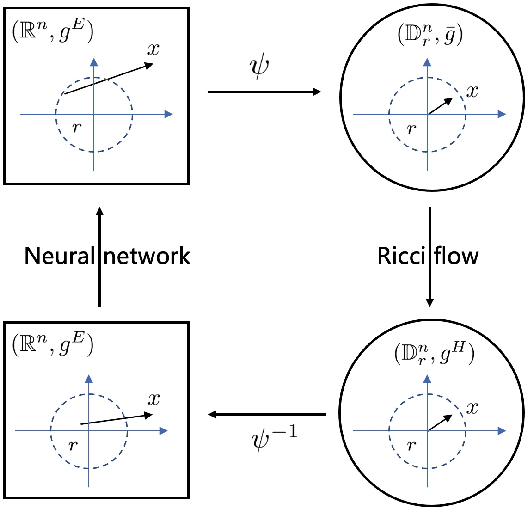
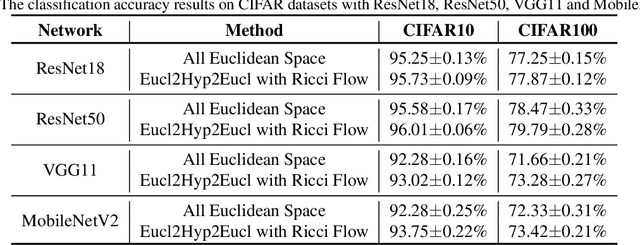
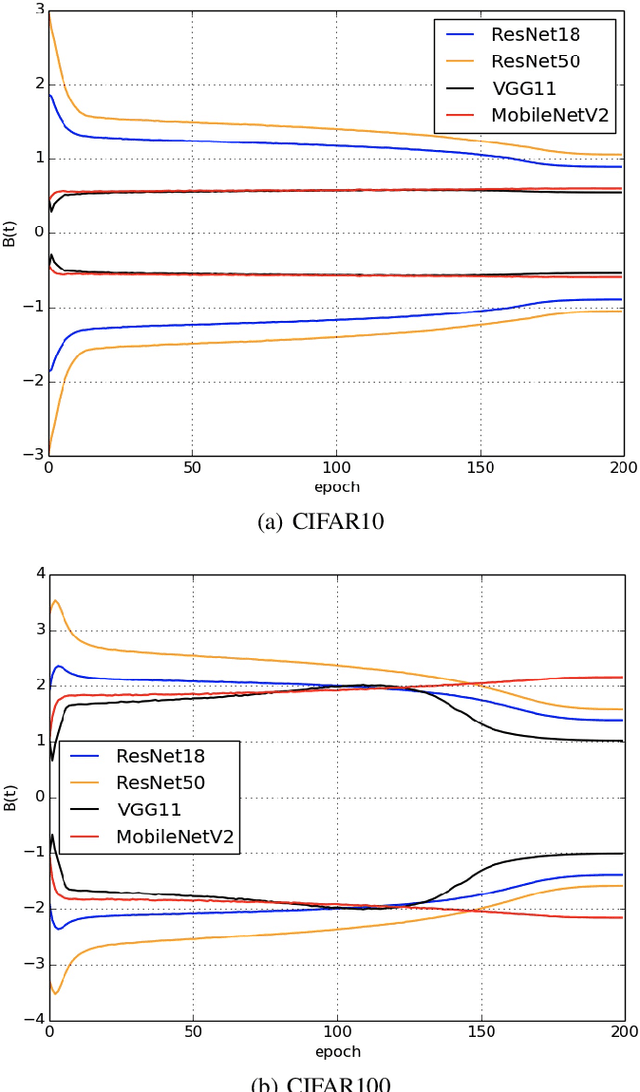
Abstract:In a Riemannian manifold, the Ricci flow is a partial differential equation for evolving the metric to become more regular. We hope that topological structures from such metrics may be used to assist in the tasks of machine learning. However, this part of the work is still missing. In this paper, we bridge this gap between the Ricci flow and deep neural networks by dynamically stable Poincar\'e embeddings for neural manifolds. As a result, we prove that, if initial metrics have an $L^2$-norm perturbation which deviates from the Hyperbolic metric on the Poincar\'e ball, the scaled Ricci-DeTurck flow of such metrics smoothly and exponentially converges to the Hyperbolic metric. Specifically, the role of the Ricci flow is to serve as naturally evolving to the stable Poincar\'e ball that will then be mapped back to the Euclidean space. For such dynamically stable neural manifolds under the Ricci flow, the convergence of neural networks embedded with such manifolds is not susceptible to perturbations. And we show that such Ricci flow assisted neural networks outperform with their all Euclidean versions on image classification tasks (CIFAR datasets).
Zero-shot Adversarial Quantization
Mar 30, 2021



Abstract:Model quantization is a promising approach to compress deep neural networks and accelerate inference, making it possible to be deployed on mobile and edge devices. To retain the high performance of full-precision models, most existing quantization methods focus on fine-tuning quantized model by assuming training datasets are accessible. However, this assumption sometimes is not satisfied in real situations due to data privacy and security issues, thereby making these quantization methods not applicable. To achieve zero-short model quantization without accessing training data, a tiny number of quantization methods adopt either post-training quantization or batch normalization statistics-guided data generation for fine-tuning. However, both of them inevitably suffer from low performance, since the former is a little too empirical and lacks training support for ultra-low precision quantization, while the latter could not fully restore the peculiarities of original data and is often low efficient for diverse data generation. To address the above issues, we propose a zero-shot adversarial quantization (ZAQ) framework, facilitating effective discrepancy estimation and knowledge transfer from a full-precision model to its quantized model. This is achieved by a novel two-level discrepancy modeling to drive a generator to synthesize informative and diverse data examples to optimize the quantized model in an adversarial learning fashion. We conduct extensive experiments on three fundamental vision tasks, demonstrating the superiority of ZAQ over the strong zero-shot baselines and validating the effectiveness of its main components. Code is available at <https://git.io/Jqc0y>.
 Add to Chrome
Add to Chrome Add to Firefox
Add to Firefox Add to Edge
Add to Edge